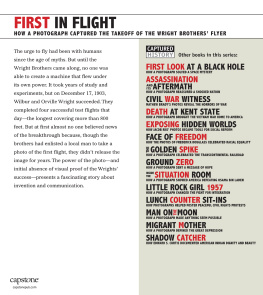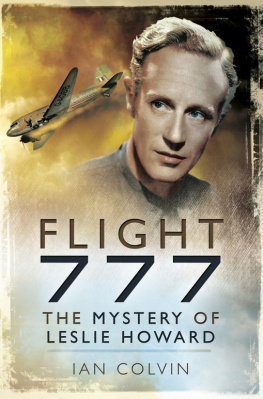This book is sold subject to the condition that it shall not, by way of trade or otherwise, be lent, resold, hired out or otherwise circulated without the publishers prior written consent in any form of binding or cover other than that in which it is published, and without a similar condition being imposed on the subsequent purchaser.
Introduction
The anxious traveller suffers in silence, experiencing discomfort from the moment they get on a plane until it lands safely.
They are not part of the group of people who absolutely refuse to fly. They are not in need of hypnotherapy nor do they require courses to tackle a fear of flying brought on by some childhood experience. They are not irrational, but simply nervous because planes do sometimes crash. Being told that flying is the safest form of travel is of little use to our anxious passenger. On hearing unfamiliar sounds in an unfamiliar environment and, particularly when experiencing turbulence, they fear being on board the next doomed aircraft. The imagination runs riot and causes worry, simply because of not really knowing what is going on. Not until landing safely will they begin to relax. Of course, the time will soon come when preparations must start for a return journey and to experience the anxiety once again. When you fly, your friends wish you a safe and enjoyable flight. Well, it is safe and it can be enjoyable.
This book is designed for the nervous flyer. It is for someone who does travel, but dreads doing it. It is for those who fly either because they have to, or because they are determined not to curtail their enjoyment of life.
We will explain to you exactly what is happening, step by step, during a typical flight, from the only point of view that matters; the viewpoint of you the passenger in your seat. It will be helpful to know what is causing the sounds and noises you hear and of comfort to realise that they are completely normal. You will learn how aircraft are able to cope with extreme weather conditions and turbulence. Conditions you are unlikely to ever encounter.
A perfectly smooth flight doesnt bother many people. It is the bumpy ones that do. Our hope is that next time you are on board an aircraft you are able to sit back and relax. Our aim is to help make your journey a lot easier and less stressful for you. Without doubt, you will have bumpy flights at some point in the future, but we want to help equip you with the knowledge you need to realise there is little to worry about.
This presentation will not make use of any hypnosis or therapy techniques. If you feel that your fear is deep-rooted in your past or that no amount of rationalising will help you then you may want to seek out any one of the excellent courses that many airlines provide to help overcome a fear of flying.
Our goal is to explain exactly what is happening on an aircraft during its journey so that you are almost a virtual pilot, familiar with not only the principles of flight and procedures involved but also with what is happening on the ground that is aiding and assisting the aircraft.
Chapter 1
On board
As you enter an aircraft and take your seat are you immediately on the alert for signs of a problem? Do you wonder about the weather? Is it raining or windy outside? Is the airline reputable? Does the plane look old? Does the captain sound competent and are the cabin crew relaxed? Perhaps you glance at the safety card and wonder how it can possibly help you, and listen to the safety demonstration, forgetting most of what you hear. There is nothing you can do; the door has now closed and you have no control over what is going to happen. It is now just a case of getting through it. You may even say a prayer or two.
Dont worry, you are not alone.
Let us start our programme with a brief lesson on just how aeroplanes fly. Part of our fear is wrestling with the concept that 400 tonnes of metal can lift into the air without a struggle. Perhaps we imagine a constant fight to stay airborne and, if so, we must dispel this idea as quickly as possible.
This lesson will be very general. Books have been written about the principles of flight and the physics involved and we dont have the space here for anything but a simplified explanation. We will, however, explain things in more detail from your passenger seat perspective as we go along.
Aeroplanes are designed to fly. That is their sole purpose. They work better in the sky than they do on the ground. And flying for them is easy. The airflow over the wings of an aircraft produces the lift that enables it to fly. The engines provide the power to reach the speeds at which the airflow is sufficient. The plane has a rudder, wings, flaps, undercarriage and a lot more, all controlled by the pilots who perform the functions required such as climbing, descending and turning.
Your aircraft will be flown by two qualified pilots: your captain and the co-pilot or first officer. They sit side by side facing the controls. A flight deck is designed so that each pilot is able to fly the aircraft independently. The controls are effectively replicated on each side so that in the unlikely event one pilot was unable to carry out his duties, the other one would be able to do so without having to leave his seat. A single pilot can safely operate and land an aircraft should it be necessary.
Airlines have strict criteria that pilots must meet before they can be considered for employment. Once selected they commence a structured training programme consisting of medical and aptitude tests before they finally qualify to fly passengers. Training and assessment is ongoing. Pilots are required to take further tests in simulators every six months and to undergo medical checks. If a pilot fails even one of these tests his licence is revoked and he must sit the tests again successfully before being re-instated to flying duties. Captains typically have thousands of hours commercial flying experience, so rest assured youre in good hands.
All aeroplanes are effectively over-designed and engineered. Aircraft operate well within what they are capable of in every single department. Whether it be acceleration, turning ability, rate of climb or descent. You name it and the aeroplane you fly in can do so much more. It flies within its capabilities for one reason only: your safety.
You already know that flying is the safest form of travel and you can be assured that aircraft are extremely safe and operate well within their limits. But as we said earlier, this is not the problem. So lets begin the flight and we would like you to imagine that we are sitting next to you. We are going to talk you through the experience of flying on a commercial airliner.
Lets move to the next chapter where we prepare for take-off.
Chapter 2
Preparing for take-off
A few things have happened while we were fighting for overhead lockers and settling into our seats. The flight crew have been conducting a thorough check on the systems of the aircraft prior to departure. The captain and his first officer have worked their way through a comprehensive list of checks that must be completed. Each check is confirmed by both pilots. These checks are carried out by every flight crew on every flight. It is mandatory and no flight can depart without satisfactory completion of the checklist. One of the two pilots will also have left the aircraft and made a visual inspection, walking around the plane to ensure there are no obstructions or anything that may be of concern to the operation of the plane. Back in the cockpit, the computer has been programmed with all the relevant information for the flight such as fuel loads, weight and route planning.














